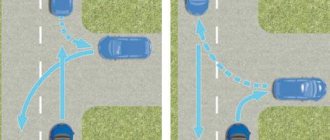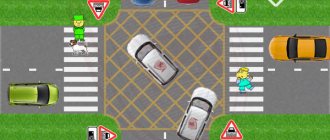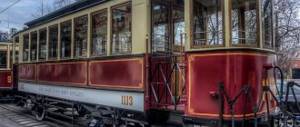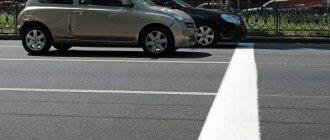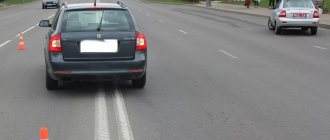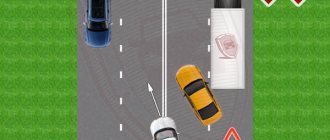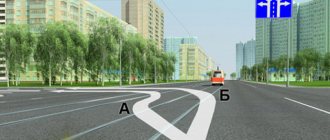Tram tracks are an integral attribute of any large old city. However, if not so long ago this method of transportation was the main one, now trams are only one of a long list of modes of transport. The rails for it are most often located on roads, so motorists constantly have to make a U-turn on the tram tracks so as not to hit the electric carrier. Moreover, drivers often encounter situations in which it is necessary to make a U-turn across tram tracks.
Traffic on tram tracks in the same direction
In order to understand when it is possible to make a U-turn on tram tracks, you first need to know whether it is possible to drive on tram tracks.
According to Rule 8.5 of the Traffic Regulations, there are a number of points at which a motorist has the right to drive on tram tracks:
- they are flush with the surrounding roadway
- they are on the left hand of the motorist
- the movement of the tram must coincide with the movement of the driver
The above opportunity appears only if all three rules are met and there is no interference with traffic. From this we can construct frequently encountered situations in which traveling on tram tracks is prohibited by law:
- 1. Tram tracks are installed on the right hand of the driver.
This situation is less common than the left-sided arrangement, but it also occurs in our country.
- 2. Tram tracks are installed on the lawn, rising above the roadway or “pressed” into the roadway, thereby being located below the road.
In this case, the rails and the surrounding area are perceived as a dividing strip along which travel is obviously prohibited by traffic rules, regardless of the presence of tracks on it.
- 3. Trying to drive onto oncoming tram tracks
This action is a violation of the rules, as it is considered a problematic situation for traffic.
In addition, every driver needs to be careful and check for special road signs and solid lines along the rails. Both of them are talking about a ban on entering the territory of tram tracks. It is also important to understand that crossing the rails that are on the right hand of the driver is strictly prohibited.
How to turn around on tram tracks: some nuances
Let's take a closer look at two situations related to characteristic nuances at and outside the intersection.
At the crossroads
Let's start with a situation where the tram driver has the right to perform any maneuver available to the tram: go straight or make a turn in any direction. The rails are located at the same level with the roadway along which the car moves towards the intersection. Let us clarify once again: entering tram tracks for the purpose of turning around is possible (and in some cases necessary) if it does not contradict the signs and markings indicated above.
Alexandrov Pavel Valerievich
Automotive lawyer at the specialized law office “Protection on the Road”, Moscow
Ask a Question
Another case is when the intersection is controlled (by a traffic light, by a traffic policeman). When permission signals are given to all traffic participants, the tram has priority in traffic. This does not depend on the direction of its movement, however, with one exception: when moving in the direction of an arrow activated in one of the additional sections simultaneously with one of the prohibitory traffic lights, the tram must wait until vehicles coming from other directions pass.
In addition, other combinations of turns on tram tracks are possible: they may depend, for example, on their location, gestures made by the traffic controller and other reasons.
Beyond the intersection
In this case, a slightly different algorithm applies:
- You should make sure that there are no restrictions already mentioned (the “left-hand rule” applies, there are no markings, and so on);
- Next, you need to give way to electric rail transport passing in the same direction, then change lanes onto the rails;
- Activate the appropriate turn signals, and, keeping the “tram traffic” in sight as a whole, make a U-turn;
- At the same time, trams traveling in the opposite direction are also allowed to pass.
Attention! Tram tracks should be used to turn around. Making a U-turn from the roadway significantly increases the possibility of collisions.
U-turn across tram tracks outside the intersection
Many people ask the question “Is it possible to turn around on tram tracks?” In order for a motorist to make a U-turn across tram tracks, he needs to perform a certain algorithm of actions:
- Check the route for legality of a turn:
- the rails are flush with the road surface
- the tracks are located on the left side of the driver
- there is no single or double solid line to the left, middle or right of the rails
2. Give way to a passing tram.
3. Change lanes along the path of passing traffic.
4. Make a left turn on the opposite route so that the car crosses them perpendicular to the traffic flow. Otherwise, the situation will be regarded as driving in the oncoming lane.
5. Drive, with or without a U-turn, onto the required highway.
After completing all the actions, the turn on the tram tracks will be considered completed correctly, and not a single traffic police representative will have any reason to make a claim.
Moving towards the tram
The movement of vehicles on the oncoming rail track is prohibited. It is only permissible to move over it, performing U-turn and turning maneuvers.
The rules govern the following exceptions:
- Repair work is often carried out at the location of the strip. Road services organize traffic flow in a detour. This situation allows the traffic police to allow the tram to bypass the obstacle along oncoming rails.
- It happens that an accident occurs near the railway tracks. In order to thoroughly understand the causes of the incident, road workers direct each car to detour into the oncoming lane of trams.
- Sometimes a traffic situation arises in which the driver of a car is transporting a patient with a critical health condition. The person needs emergency medical help and should be hospitalized as soon as possible. The road runs only through oncoming tracks with rails. If there are no other routes for travel, as an exception, trams are allowed to travel in the oncoming lane in compliance with increased safety measures.
Often, even with a favorable court ruling, the violator is punished. Law enforcement officers issue a financial penalty, which the offender must pay.
U-turn at an intersection
Let's consider a situation where it is necessary to make a U-turn at an intersection with tram tracks. To make a correct turn across tram tracks according to traffic regulations, the roadway must meet the following criteria:
- tram tracks are located to the driver's left;
- tram tracks and road surface are on the same level;
- movement along tram tracks and the road surface is carried out in one direction.
If the road meets these criteria, you are required to drive onto the passing lane of the tram tracks and make a U-turn on the tram tracks or turn left.
According to traffic rules, a U-turn or a left turn is made from the leftmost lane . If there is no demarcation (curb or other element of structural separation of roads), as well as in the absence of signs 5.15.1 and 5.15.2 and road markings 1.18, the passing lane of the railway tracks is the leftmost lane, so turns to the left and a U-turn are carried out with it.
Video: rules for turning around outside an intersection across tram tracks.
Cases when the maneuver is permitted
Before describing the rules, it is necessary to clarify what is considered a reversal. In addition to the familiar maneuvers, this concept also includes when tram tracks intersect in its process in order to change the direction of movement. This can be done in different ways, depending on where the car is moving - at the intersection or not in its area.
Turning around on tram tracks is allowed, but it must be carried out in accordance with the following rules:
- clause 8.5: when turning or turning around, you need to take the extreme place on the road with passing traffic (exception: roundabouts). Passing paths may be on the right; then, if they are at the same level with the road, maneuvers are made from them, except when signs provide for another option. In all driving options there should be no interference with the tram;
- clause 8.8: when turning left or making a U-turn not at an intersection, the driver is obliged to give way to oncoming vehicles and passing trams;
- clause 9.6: passing along the rails on the left is allowed when all passing parts of the road are occupied, as well as during detour maneuvers, turning left and during turns according to clause 8.5. If signs 5.15.1 – 2 provide for a different procedure, then you must carry them out; other maneuvers are prohibited.
There is an opinion that there cannot be “oncoming traffic” during turns, since this is a full-fledged maneuver that changes the direction of the vehicle. For this reason, this violation can only be charged if it occurred before the car began to turn or after, but not during the maneuver. According to this position, driving onto the rails with oncoming traffic is prohibited, except for a U-turn, and there should be no claims against the driver.
With this position, everything depends on whether the driver can prove it to the traffic police, otherwise - an impressive fine.
Turning at an intersection with tram tracks
Turning left from tram tracks, as well as turning across them, are carried out in the same way. However, you need to be careful in several other aspects:
- Do not try to cross the tram tracks located on the left side of the driver, perpendicular to both directions of movement of electric transport. Changing to co-directional tram tracks is mandatory in any case.
- In situations where a traffic controller or traffic light simultaneously allows the movement of both types of transport, according to clause 13.6 of the Road Traffic Rules, car drivers are required to let a representative of rail transport pass.
- An exception to the above point is the situation when, simultaneously with warning or prohibiting traffic lights, the arrow in the direction of movement is lit, then motorists and tram drivers change places, and the latter give way to the former.
Rules for making a left turn or U-turn when there are tram tracks at an intersection.
Causes of an accident during a U-turn and the chances of avoiding it
The speed at which the cars were moving is important.
Therefore, in the investigation of a collision during a U-turn at an intersection, a technical examination is often assigned. Eyewitness testimony and dashcam footage will also be useful.
The degree of responsibility of the guilty motorist is determined by the section of the Code of Administrative Offenses that he violated. This may be a fine under Articles 12.14, 12.15, Part 2 of Article 12.16 of the Code.
And if there are serious injuries or deaths as a result of an accident, the Criminal Code applies. And the culprit may lose his freedom. In any case, his insurer will have to pay money to repair the victim’s car.
Accidents at unregulated crossing points occur not only due to ignorance of traffic rules, but also due to the inattention of drivers. And the problem can be avoided if all potential participants act correctly: It is better for the one turning left to do so along the same trajectory as the car in front.
Fine for driving on tram tracks
There are often situations in which a motorist may hesitate or, due to inexperience or inattention, make an incorrect turn. If a traffic police officer notices this, the driver faces a fine for:
- stop on tram tracks - from 1.5 to 3 thousand rubles depending on the city in which it happened
- moving a continuous line - from 500 to 1500 rubles
- interference with tram traffic – up to 500 rubles
- travel on oncoming roads - up to 5 thousand rubles, in especially severe cases, deprivation of rights for a period of 4 months to 1 year is possible
- traveling to oncoming roads to avoid obstacles - from 1 to 1.5 thousand rubles
The rules for crossing tram tracks when there is communication in both directions are fully regulated. However, the traffic rules do not contain regulations for roads where rail traffic moves only in one direction. If a motorist is on such a highway, then he should be more careful and, in case of danger to his life or wallet, try not to make a U-turn and get to the intersection.
Turn on the tracks
Let's say you need to cross tram tracks in order to start moving in the opposite direction from the current one. This action will be considered a reversal. It can be done in different ways. Much will depend on whether the car is at the intersection or outside it.
At the crossroads
Let's consider a situation where tram tracks allow the tram to perform any maneuver, be it moving straight or turning left/right. If in your case at the intersection tram tracks connect only some directions, then the rules of travel will be significantly simplified for you.
So, the roadway along which you approach the intersection is divided by tram tracks located on the same level as it. Is it possible to turn around on tram tracks, in this case? According to clauses 8.5 and 9.6. According to traffic regulations, you can (and sometimes are required to) drive onto the tram tracks to make a U-turn. However, your maneuver must not contradict road signs 5.15.1 and 5.15.2 and road markings 1.18. In addition, it should not create difficulties for other road users.
As for the relationship between car drivers and trams at signalized intersections, they are described in detail in clause 13.6 of the traffic rules, which states that:
In a situation where traffic light/regulator signals simultaneously allow the tram and other trackless vehicles to move, the tram will always have priority, regardless of which direction it is moving. However, if the movement is in the direction of the arrow, which was activated in the additional section at the same time as the red/yellow traffic light signal, the tram is obliged to give way to vehicles moving from other directions.
Please note that we have described only the general rules for turning around on tram tracks, because combinations, depending on the position of the tram tracks, gestures of the traffic controller, etc., can be counted in hundreds. If you have any questions or clarifications regarding them, then welcome to the comments.
More on AutoLex.Net:
Car mileage - how to calculate or find out the mileage?
Outside the intersection
A U-turn across tram tracks outside an intersection should be carried out as follows:
- Make sure that the tram tracks are located on your left and are not higher than the roadway; there are no restrictions described above (markings, places prohibited for turning, etc.).
- Give way to passing trams and change lanes onto tram tracks in the same direction.
- Turn on the turn signal and, while watching the movement of trams in both directions, make a U-turn. Oncoming trams must also be allowed to pass.
The most common mistakes when performing a reversal:
- The turn is made from the roadway, not from the tram tracks . Although there is no legal liability for such a maneuver, you significantly increase the likelihood of an emergency. While you begin to turn, you risk colliding with a car moving along the tram tracks.
- U-turns are made from oncoming tram tracks . There is a gross violation of clause 9.6 here. Traffic regulations, namely: “exit and movement onto tram tracks in the opposite direction.”
- When entering the tram tracks in the opposite direction, the vehicle turned out to be not perpendicular to them (the tracks) . In this case, the maneuver may be presented by traffic police officers as driving onto tram tracks in the opposite direction, and may result in a fine.
- When turning, there are parked cars on the left side relative to the traffic. In this case, you should start turning when the “nose” of your car and the parked car are on the same line; such a position, in limited space, will allow you to avoid collisions with parked vehicles.
Video: Correct and incorrect turns from tram tracks
The number of accidents involving trams and cars is only increasing every year.
In 95% of cases, the driver behind the wheel of the car is recognized as the culprit of the emergency situation, since when driving onto the tram tracks, he is obliged not to interfere with the movement of the tram. There are also cases where the fault lies with the tram drivers (who, for example, drove when the traffic light signal was prohibiting), but their number does not exceed 5% of all cases. However, even without an emergency, driving along tram tracks, a motorist can receive a fine or even lose his driver’s license. The size of the punishment directly depends on the clause of the traffic rules that was, in this case, violated. So:
- For stopping on tram tracks you will have to pay: 3 thousand rubles, if this happened in St. Petersburg or Moscow, 1.5 thousand rubles. – in any other city of the Russian Federation.
- Interfering with a tram moving in the same direction will result in a fine of 500 rubles.
- For violating road marking rules you will have to pay from 500 rubles. up to 1500 rubles (when turning/turning in violation of the markings).
- Driving onto oncoming tram tracks for the first time will cost the driver 5 thousand rubles (or deprivation of rights for 4 - 6 months), and repeated deprivation of rights for a year.
- Driving onto oncoming tram tracks to avoid obstacles will cost the driver from 1 to 1.5 thousand rubles.
Remember, when turning around on tram tracks, you should always let the tram through first, even if its movement grossly violates traffic rules. Otherwise, the consequences of an accident for your car (and for yourself) may be much more serious than for a tram.
Signalized intersection with tram tracks
When a traffic light signal at an intersection allows a tram and a trackless vehicle to move simultaneously, and their movement trajectories intersect, the tram has priority, regardless of the direction of its movement (clause 13.6 of the traffic rules).
For example, if the tram is traveling in the same direction as you, the tram moves straight, but at the intersection you need to turn left across the tram tracks - the tram has the advantage. Or the tram turns right at the intersection, but you need to go straight across the tram tracks - in this situation the tram also has an advantage.
The tram at a controlled intersection always goes first, except when it moves to the arrow in the additional section of the traffic light, which is turned on simultaneously with the red or yellow signal.
When passing trams, you should pay attention to one point. When you move along with a tram, you can see at which signal the tram started moving - to the main one or to the switch, and you can easily set priorities, i.e. who can cross the intersection first.
But what if the tram is moving from the direction opposite to you, and you need to cross the tram track? In this case, you will not be able to immediately determine whether it is going to the arrow or to the main signal. Besides, there won't be time for this. Read below for a solution to this situation.
In the article Driving in Traffic, the topic of the advantage of travel was touched upon. So: the advantage of passage is determined not only by formal priority (permissive signal, etc.), but also by the guarantee of the absence of an accident. This applies to absolutely all road situations, including those involving a tram. Imagine, if a tram and a car collide, which of them will win?
The correct answer is that no one will win, but the car will suffer more, this is a well-known fact.
Therefore, in such cases, at a controlled intersection, when a tram is moving towards you and your paths intersect, it is recommended to always give way to the tram. If you have the advantage in traffic and at the same time give way, you are not violating the Rules, but you are acting according to the situation.
